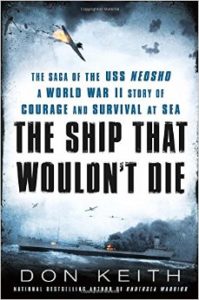 By Don Keith, Penguin Group, New York, NY (2015)
By Don Keith, Penguin Group, New York, NY (2015)
Reviewed by Michael F. Solecki
During the Battle of Coral Sea in May 1942, the Japanese sank Neosho and her escort Sims. A sidebar of the battle until recently, the sinking of these two ships developed into a fascinating story of survival and heroism. I am happy to see that this fascinating story has finally become more of interest. Neosho was a fleet-oiler (AO 23) with a Japanese sounding name that is actually an Osage (Native American Tribe) word meaning “clear-water,” named for a Kansas tributary of the Arkansas River. The ship, a 553-foot Cimarron-class oiler with a tank capacity of approximately 150,000 barrels (42g/bbl.) and a crew compliment of 293 officers and enlisted. An “AO” is what sailors affectionately call a “fast-attack” oiler, as she was armed with four 5” dual-purpose guns and four 20mm Oerlikon anti-aircraft cannon for defensive purposes. The Sims (DD 409), the lead of the class, a 338-foot, single stack destroyer, with a crew compliment 252 officers and enlisted, was named for Vice Admiral William Sowden Sims (USNA 1880).
Keith begins the story at Pearl Harbor where Neosho, the center piece of this amazing yarn, began its “wartime” service on December 7, 1941. She was flying “baker,” (off-loading fuel) at her Ford Island manifold-berth adjacent “battleship row” when the Japanese Naval Air Force attacked. Though not directly related to the main story, Keith uses the tenacity of their actions to identify the crew and their skipper, Captain John Spinning Phillips (USNA 1917) early in the chronology. Sims of Destroyer Squadron TWO, on that “Day of Infamy” was assigned to escort the carrier Yorktown (CV 5) as part of Task Force 17 (TF-17) under Admiral Frank Jack Fletcher (USNA 1906) from its base in Norfolk, Virginia to Pearl Harbor, HI. Sims’ skipper was newly appointed Lieutenant Commander Wilford M. Hyman (USNA 1924).
By May of 1942, TF-17 with newly assigned Neosho was on station in the Coral Sea ordered to prevent Admiral Chuichi Hara’s 5th Carrier Division (IJN-5CD) from carrying out Operation MO, the reinforcement of Port Moresby. TF-17 was a tough job for an oiler. Fletcher, always concerned with his ships running out of fuel in the middle of a fight, required constant fuel top-offs for his fleet. On May 7, the eve of battle, Fletcher reluctantly ordered the Neosho to complete top-off duties and move about two-hundred miles away from the main body and wait until called. Sims, having mechanical reliability issues, was sent as escort.
Early that day, a rookie IJN-5CD pilot spotted the two ships and reported them as a carrier and cruiser (not an uncommon mistake). The excited Japanese responded by sending a group of planes to attack the two American ships. The author gives a fair account of what the Japanese were thinking and doing during this period on the timeline. Here is where the real story begins.
The battle was ferocious. The Sims went down relatively fast and unexpected with all officers and all but 14 of her now adrift enlisted crew. The author does not intend to slight this part of the story however; minimal factual information is available about the sinking. The author makes a valiant attempt to explain why the Sims went down as she did. He also tracks the wayward survivors until their rescue. The Neosho on the other hand had a different fate.
Technical details of what was going on with the ship itself were not lost in the human story. Keith emphasizes the importance of the actions performed to keep as much of the ship as possible above water as well as the bravery of the men who had to act on them. An early misunderstood order to abandon ship by part of the crew led to men and life boats and rafts in the water. A problem with the Navy’s official Standard Operating Procedures (SOP) to “abandon ship” is brought to the surface during this incident resulting in changes to the SOP. The adventure experienced by the part of the adrift crew that abandoned the ship as well as those who did not is the bulk of the story and described in great detail; again relying on personal accounts and Keith’s gift to turn a yarn.
Contradictory to other material I have read of this incident, Keith made me feel as though I was watching it in real time, not just reading data. In spite of the complexity of the surviving crew members, he adequately coordinated the timeline with the main battle while remaining focused on the crux of the story. The battle that ensued against nature is well presented; eye witness quotes, novelized explanations and personal thoughts keep it interesting. As a historian I have difficulty with “perspective” when using personal accounts as they tend to be skewed toward sensationalism, good or bad. It appears the author took that into consideration when reiterating. I highly recommend reading the “Author’s Notes” first as it explains the author’s attitude toward the reader and intent behind his literary method. Though a few vintage photographs of the ships and crew members would have been nice the work is worth the price of admission for the serious historian as well as those who just like a good yarn.
Michael F. Solecki, is an independent naval historian, holds a Master of Arts in Military History degree from Norwich University and a U.S. Naval and NOAA veteran where he acquired, processed and disseminated environmental intelligence for Weapons of Mass Destruction, Anti-submarine and Anti-Aircraft Warfare. Beside his current civilian job with the U.S. Government, he performs technical peer reviews for several publishers of U.S. and Japanese naval history.


Sue McCarville